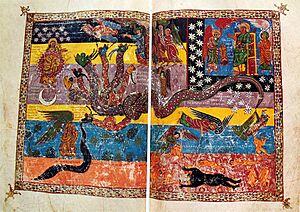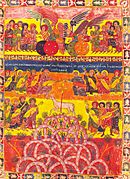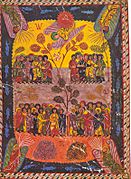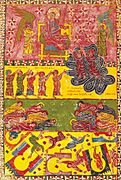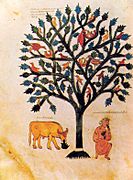Morgan Beatus facts for kids
The Morgan Beatus is a very old and beautiful book. It's an illuminated manuscript, which means it's a handwritten book decorated with amazing pictures called miniatures. This special book was made by an artist named Magius (or Maius).
It contains a famous text called the Commentary on the Book of the Apocalypse. This text was written by a Spanish monk named Beatus in the 700s. It talks about the "end of days" and the "Last Judgment," which are important ideas in Christianity.
The Morgan Beatus was likely made in a place called a scriptorium (a room where monks copied and decorated books) at San Miguel de Escalada in Spain. It was created around the 900s, making it one of the oldest examples of a special Spanish art style.
This book was made by Mozarabs. These were Christians who lived in Spain when it was ruled by Muslim leaders, often called Moors. The Morgan Beatus shows how Christian and Muslim art styles mixed together during that time, especially in places like Léon and Córdoba. The Book of Apocalypse and Beatus's comments on it became very important religious texts in the Middle Ages, and they were often illustrated with many detailed pictures.
What's Inside the Morgan Beatus?
The Morgan Beatus is a large book with about 300 pages, called leaves. These pages are made of high-quality parchment, which is a strong material made from animal skin. The colors in the book are still very bright and clear, even after more than 1,000 years!
The book starts with beautiful pictures of the four Evangelists (the writers of the Gospels in the Bible). Then comes Beatus's main commentary on the Apocalypse. It also includes parts from other important texts, like those by Isidore of Seville and St. Jerome.
We know that Magius was the artist who made this book because his name is written in a special note at the end, called a colophon. This note also gives a hint about when the book was finished and mentions the monastery where it was made.
The bookmakers used a system of Roman numerals and the letter "Q" to keep the pages in the right order. This helps experts figure out how old the manuscript is. The first few pages of the book seem to have been added a bit later than the rest.
The Woman and the Dragon Picture
One of the most famous pictures in the Morgan Beatus is called Woman clothed with the sun escaping from the dragon. This artwork is a great example of how Christian and Muslim art styles blended together.
The picture shows a scene from the Bible's Book of Revelation (Chapter 12). It features a woman, who often represents the Virgin Mary, escaping from a scary, seven-headed dragon. The dragon stands for the devil or Satan.
The dragons in the picture are colored with bright red and purple inks. They have features like red tongues and bulging eyes, which were common in Islamic art. This mix of styles is what we call Mozarabic art. The word "Mozarabic" comes from an Arabic word meaning "like an Arab."
Maius, the artist, used this new style to show biblical scenes. For example, you can see angels falling from heaven and fighting the dragon alongside the archangel Michael. The woman also has a crown of 12 stars, which is often seen with the Virgin Mary.
This artwork, and others in the book, also commented on ideas about the apocalypse. During that time, there were different beliefs about Jesus. Some people believed in something called Adoptionism, which said Jesus was born human and then adopted by God as His son. Monk Beatus of Liébana disagreed with this idea, calling it a heresy (a belief that goes against official church teachings). He also challenged some of the growing Islamic ideas. Maius's art in this book helped to show Beatus's views.
Maius's work, with its bright colors, abstract shapes, and patterned borders, created a unique bridge between Christian and Islamic communities. This happened even during times when there were big power struggles between them in the 900s.
Gallery
See also
 In Spanish: Beato Morgan para niños
In Spanish: Beato Morgan para niños



